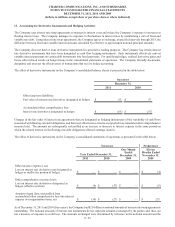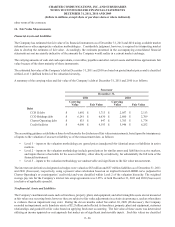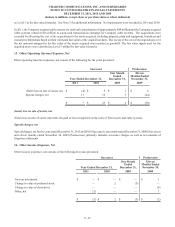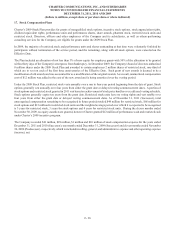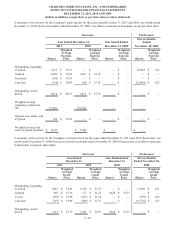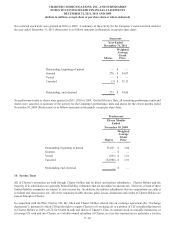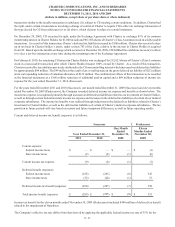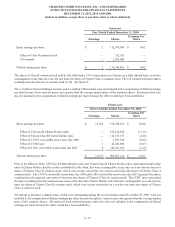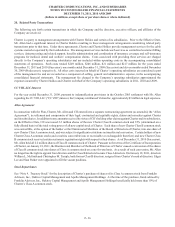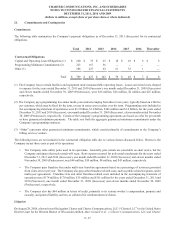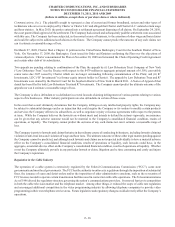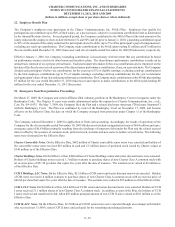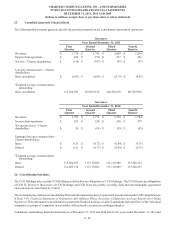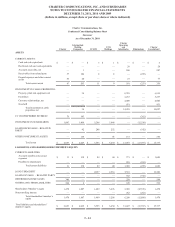Charter 2011 Annual Report Download - page 118
Download and view the complete annual report
Please find page 118 of the 2011 Charter annual report below. You can navigate through the pages in the report by either clicking on the pages listed below, or by using the keyword search tool below to find specific information within the annual report.
CHARTER COMMUNICATIONS, INC. AND SUBSIDIARIES
NOTES TO CONSOLIDATED FINANCIAL STATEMENTS
DECEMBER 31, 2011, 2010 AND 2009
(dollars in millions, except share or per share data or where indicated)
F- 34
carryforwards, resulting in a gross deferred tax asset (net of federal tax benefit) of approximately $252 million, generally expiring
in years 2012 through 2031.
Upon emergence from bankruptcy, Charter experienced an “ownership change” as defined in Section 382 of the Code. Therefore,
the use of Charter’s tax loss carryforwards is subject to certain limitations under Section 382. As of December 31, 2011 (Successor),
$2.6 billion of federal tax loss carryforwards are unrestricted and available for Charter’s immediate use, while approximately $4.8
billion of federal tax loss carryforwards are still subject to Section 382 restrictions. Pursuant to these restrictions, an aggregate
of $1.5 billion, in varying amounts from 2012 to 2014, and an additional $176 million annually over each of the next 17 years of
federal tax loss carryforwards, should become unrestricted and available for Charter’s use. Those limitation amounts accumulate
for future use to the extent they are not utilized in a given year. Charter’s state loss carryforwards are also subject to similar, but
varying, restrictions on their future use. Charter’s indirect corporate subsidiaries are also subject to separate Section 382 limitations
on the utilization of their net operating loss carryforwards. If the Company was to experience another “ownership change” in the
future, its ability to use its loss carryforwards could be subject to further limitations.
In determining the Company’s tax provision for financial reporting purposes, the Company establishes a reserve for uncertain tax
positions unless such positions are determined to be “more likely than not” of being sustained upon examination, based on their
technical merits. There is considerable judgment involved in determining whether positions taken on the tax return are “more
likely than not” of being sustained. A reconciliation of the beginning and ending amount of unrecognized tax benefits included
in other long-term liabilities in the accompanying consolidated balance sheets of the Company is as follows.
Balance at December 31, 2009 (Successor)
Additions based on tax positions related to current period
Reductions due to tax positions related to prior year
Balance at December 31, 2010 (Successor)
Additions based on tax positions related to prior year
Reductions due to tax positions related to prior year
Balance at December 31, 2011 (Successor)
$ 23
228
(27)
224
64
(60)
$ 228
Included in the balance at December 31, 2011, are $4 million of net additions to uncertain tax positions for which the ultimate
deductibility is highly certain, but for which there is uncertainty about the character of the deductibility. Included in the balance
at December 31, 2010, are additions to the uncertain tax position of $228 million related to a 2009 tax position for which the
ultimate deductibility is highly certain, but for which there is uncertainty about the character of the deductibility. The change in
character of the deduction would not impact the annual effective tax rate after consideration of the valuation allowance. The
deductions for the uncertain tax positions are included with the loss carryforwards in the deferred tax assets.
The Company does not currently anticipate that its existing reserves related to uncertain income tax positions as of December 31,
2011 will significantly increase or decrease during the twelve-month period ending December 31, 2012; however, various events
could cause the Company’s current expectations to change in the future. These uncertain tax positions, if ever recognized in the
financial statements, would be recorded in the consolidated statement of operations as part of the income tax provision.
No tax years for Charter or Charter Holdco are currently under examination by the Internal Revenue Service. Tax years ending
2008 through 2011 remain subject to examination and assessment. Years prior to 2008 remain open solely for purposes of
examination of Charter’s loss and credit carryforwards.
19. Earnings (Loss) Per Share
Basic earnings (loss) per share is based on the average number of shares of common stock outstanding during the period. Diluted
earnings per share is based on the average number of shares used for the basic earnings per share calculation, adjusted for the
dilutive effect of stock options, restricted stock, performance shares and units, convertible debt, convertible redeemable preferred
stock and exchangeable membership units. Basic loss per share equaled diluted loss per share for the years ended December 31,
2011 and 2010 (Successor), as the effect of stock options and other convertible securities are antidilutive because the Company
incurred net losses.



